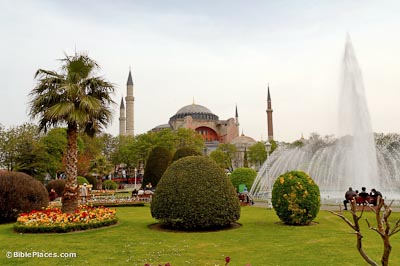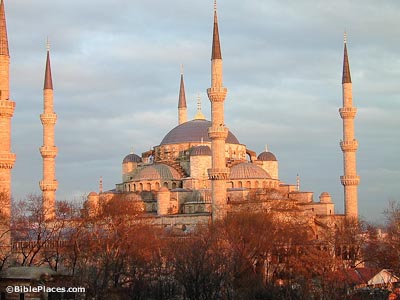Hagia Sophia, “Holy Wisdom,” was originally a basilica style church built in the 4th century. After the church burned down twice, Emperor Justinian built the present, fireproof structure around AD 537. Hagia Sophia served as a Christian church for 900 years until 1453, when Moslem Turks took the city and converted it into a mosque. In 1935, it was turned into a public museum.
Istanbul

Hagia Sophia
St. Sophia Cistern
A legend about the design of the church says that one day during Mass, Emperor Justinian dropped the holy bread from his hands. Before he could grasp it, a bee picked it up and flew away. Justinian sent a message to all beekeepers in the empire to look for the bread in their hives. After a couple of days, a beekeeper arrived with a hive of peculiar design. Upon seeing it, Justinian decided that he would build a magnificent church with the design of this hive as its ground plan.


Church of St. Irene
Before the Byzantine era, the city of Istanbul was called Byzantium. The Roman Emperor Constantine I made the site the new capital of the Roman Empire, naming it Constantinople. Shown here is the church of St. Irene. The second church council was held in the church in 381, but that building burned down and was rebuilt by Justinian in 532. It was later enlarged by another ruler.
Topkapi Palace
Mehmet II constructed Topkapi palace atop the Byzantine acropolis around AD 1500 and Ottoman sultans after him continued to build up the site. It was the residency of the sultan, his harem, and all the wives and concubines of the former sultans. They continued to reside here until 1909 when the harem was dissolved. Today the four courts and harem are open to visitors.


The Blue Mosque
Between 1609 and 1616, the Blue Mosque, also called the Sultan Ahmet Camii, was partially built over the hippodrome and partially over the site of the Byzantine imperial palace. Sultan Ahmet I ordered architect Mehmet Aga to construct the mosque, possibly in competition with the Hagia Sophia, located just across from it. It has seven minarets and 260 windows.

Download all of our Western Turkey photos!
$34.00 $49.99 FREE SHIPPING
Related Websites
For historical images of mosques, see Life in the Holy Land.
Byzantium (Livius) This page explores the city’s history across several different tabs. Under the “Photos” tab, it also links to many different pages for important structures related to the city.
Constantine’s Capital City (Bible History Daily) A helpful introduction to the city’s history.
Byzantium (Internet Medieval Sourcebook) Extensive collection of ancient texts related to the city of Byzantium.
Byzantium 1200 (Byzantium 1200) Provides beautifully detailed computer reconstructions of Byzantine structures as they looked in AD 1200.
Byzantium (The Metropolitan Museum of Art) This page is most interesting for its quality photos of artifacts related to the city.
Byzantium: Byzantine Studies On The Internet (Fordham University) Includes information about Byzantium’s legacy and links to many other related resources.
Istanbul Dig Yields Evidence of City’s Ancient Harbor (Bible History Daily) This 2012 article includes just one paragraph and one photo about the excavation.
Hagia Sophia (World History Encyclopedia) This article is a fascinating introduction to this building, including construction history.
Hagia Sophia Throughout History: One Dome, Three Religions (The Collector) This article is especially notable for the historic photographs.
Basilica Cistern (Hagia Sophia official site) Features a lovely collection of photos, old and new, in addition to interesting information about the area.
Hagia Irene: Guide To The Oldest Church in Istanbul (Absolute Istanbul) One of the highlights of this article is the timeline, along with background information for how the church was named.
Topkapi Palace Museum (official site) Guide to one of the best museums in Turkey, including a floor plan and photos of major artifacts from the reigns of the sultans.
Blue Mosque (Britannica) An encyclopedia introduction to this beautiful structure.